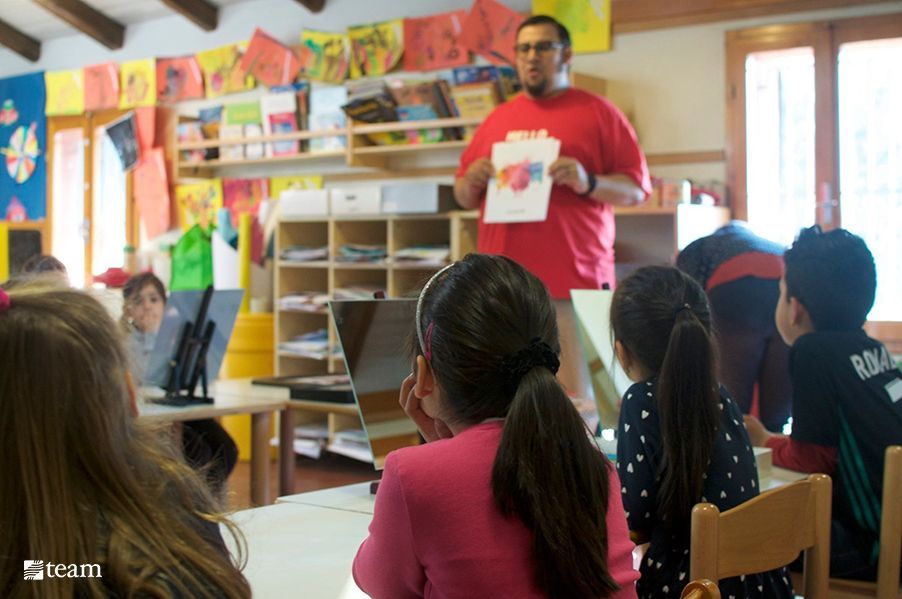We all have gifts that God has given us to effectively share the Gospel. Have you ever considered that your fluency in English is one of them?
Today, more and more people are getting certified in Teaching English to Speakers of Other Languages (TESOL) and using it overseas to meet practical needs and make disciples.
Kristin Dykstra, a TEAM missions coach serving in Illinois, majored in TESOL at Moody Bible Institute and now equips others to use English education in global missions. Her love for TESOL first grew while participating in a student exchange program in Russia, teaching English to non-native speakers. Since then, she has used her TESOL degree in the United States, Italy and South Korea.
So, if you’ve ever wanted to teach English overseas , read on for some insights we gleaned from Kristin about the needs, the opportunities and next steps in pursuing TESOL.
Why has teaching English become a need?
Kristin puts it this way, “We live in a globalized world. More and more we’re seeing many people of all nations living in the [United States] and vice versa. It’s even bigger than that. … [It’s a] migration movement, and with movement, we need good communication.” And for much of the world, the English language is a common denominator.
Can I just go teach? Or do I need training in TESOL?
You don’t necessarily need to have TESOL training. But to teach English for any extended period of time, you should. Here’s why:
Getting a TESOL certification is really about preparing yourself to teach with excellence.
Kristin says, “My main passion is that, when it comes to overseas opportunities , teachers are very well-trained and really know how to teach with excellence. We never want to take away the opportunity from a national [teacher]; however, many countries do want native English speakers to fill these kinds of positions.”
And more importantly, a well-trained teacher shows a commitment to Christ : “We want to represent Christ and do things to the best of our ability. The same is true with teaching English. We get adequate training to best help the people we’re going to serve. And it turns into a relationship through that.”
There are two ways to get TESOL training: through a college degree program or a certification course.
Kristin explains, “One of the best ways is to major in either TESOL or in Education with a focus in TESOL while in undergrad. This gives you a full sense of grammar and how to teach and how to design curriculum. Not all schools have TESOL programs, but it’s becoming more and more common. You could also get an education degree with a focus on TESOL.”
Alternatively, there are many certification courses offered both online and in person. The best-known course is a Cambridge course called CELTA. It’s an intense certification getting you certified as quickly as one month, but it is recognized internationally.
Where can I use my TESOL certification?
Locally
There are opportunities to teach English locally through refugee resettlement agencies. Other opportunities are available with community centers — especially in diverse neighborhoods. Check out your local community center to see if there is a need and how you can help.
A second avenue is to teach in a school system. A full teaching position may require a degree, but being certified could allow you to teach after-school programs as well.
Globally
Teaching English can take you across the world. Many of the opportunities are in the Middle East and Asia. Europe is seeing a greater need as well because of many refugees resettling in European countries.
TEAM partners with schools overseas that are actively searching for TESOL-certified individuals to come and serve in places like Spain , Taiwan or Ukraine.
How does teaching English overseas spread the Gospel?
Teaching English allows missionaries to provide a service that meets a tangible need. This is important as many countries legally prohibit religious workers. The platform of teaching provides a legitimate way for missionaries to enter a country.
And, ultimately, teaching builds relationships with dozens of students, parents and co-workers that otherwise wouldn’t be possible. This happens in places like the Czech Republic , where middle school teachers connect with students and staff from more than 30 towns and villages. Or in places like Chad, where English teachers are connecting with Muslims who have never heard the Gospel.
The opportunities to make an eternal impact through teaching English are real and wide open. Consider one of the over 250 ways you can teach overseas. Where will you go be a teacher?




















